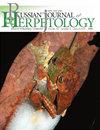俄罗斯东南部的假春天和Pallas‘Spadefoot蟾蜍Pelobates vespertinus(Pelobatidae,Amphibia)产卵迁徙表型的异常
IF 0.9
4区 生物学
Q3 ZOOLOGY
引用次数: 2
摘要
2020年3月,在Medveditsa河谷发现了异常早的Pelobates vespertinus产卵迁徙。3月13日,在Troynoye湖的浅水中发现了从冬眠状态中出现的雄性,比过去30年的长期平均日期早一个月,比最早记录的日期早了近两周。从1892年到1990年,假春物候情景仅发生了6次,而在过去30年(1991 - 2020年)中发生了7次。1990 - 2020年假弹簧类型的弹簧过程发展的第二个特征是反复出现的回冷。在春季过程的早期发展和返寒的反复周期背景下,产卵迁移期的离散性(不连续)的出现是无尾两栖动物物候学的一个相对较新的特征。从产卵迁徙开始之日起的第1天到第5天内到达产卵生物群的雄鱼累积比例平均(中位数)从成年雄鱼总数的4%增加到38%。2014年,发现在头五天内来到产卵生物群落的雄性比例发生了突然变化:2009年至2013年,这一比例不到雄性总数的四分之一(15 - 23%),2014年至2017年,这一比例为一半或更多(43 - 70%)。这种物候异常的后果可能成为降低斑蝶繁殖成功率和当地种群退化的另一个因素。此外,春季过程的异常发育需要对普查技术进行校正,并对胡蜂种群的性别结构进行分析。本文章由计算机程序翻译,如有差异,请以英文原文为准。
False Spring in the Southeastern European Russia and Anomalies of the Phenology of Spawing Migrations of the Pallas’ Spadefoot Toad Pelobates vespertinus (Pelobatidae, Amphibia)
In March 2020, an anomalously early start of the spawning migrations of Pelobates vespertinus was established in the Medveditsa River valley. Males of this species, emerging from a state of hibernation, were observed in the shallow waters of the lake Troynoye on March 13, one month ahead of the long-term mean date over the past 30 years and almost two weeks before the earliest recorded date. From 1892 to 1990 the phenological scenario of a false spring was realized six times only, while seven times — over the past 30 years (1991 – 2020). A second feature of the development of spring processes by the type of false spring in 1990 – 2020 is repeated recurrence of return cooling. The emergence of discreteness (discontinuity) of the spawning migration period against the background of early development of spring processes and repeated periods of return cold is a relatively new feature of the phenology of anuran amphibians. The cumulative proportion of P. vespertinus males arriving at their spawning biotopes from the first to the fifth day from the date of the start of spawning migrations of the species increases on mean (median) from 4 to 38% of the total number of mature males. In 2014, an abrupt change in the proportion of males who came to spawning biotopes during the first five days was found: in 2009 – 2013 was less than a quarter of the total number of males (15 – 23%), and in 2014 – 2017 it was half or more (43 – 70%). Consequences of such phenological abnormalities can become an additional factor in reducing the reproductive success of P. vespertinus and degradation of their local populations. In addition, the abnormal development of spring processes requires correction of census technique and analysis of the sex structure of P. vespertinus populations.
求助全文
通过发布文献求助,成功后即可免费获取论文全文。
去求助
来源期刊

Russian Journal of Herpetology
ZOOLOGY-
CiteScore
1.70
自引率
0.00%
发文量
29
期刊介绍:
Russian Journal of Herpetology is an international multi-disciplinary journal devoted to herpetology. Russian Journal of Herpetology accepts original papers on ecology, behavior, conservation, systematics, evolutionary morphology, paleontology, physiology, cytology and genetics of amphibians and reptiles.
Types of Contributions:
-original papers
-invited or contributed reviews on specific topics
-short communications on topics of immediate interest, new methods and ideas in progress
-notices of meetings, symposia, and short courses
-book reviews
 求助内容:
求助内容: 应助结果提醒方式:
应助结果提醒方式:


